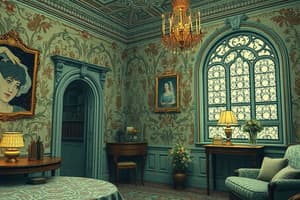Podcast
Questions and Answers
Land introduced “Polaroid” the one-step-photography in ________
Land introduced “Polaroid” the one-step-photography in ________
1947
Dr. Richard L. Maddox developed a dry plate photography eclipsing Daguerre's wet plate on tin method in ________
Dr. Richard L. Maddox developed a dry plate photography eclipsing Daguerre's wet plate on tin method in ________
1854
One of the earliest applied forensic science involving photography in the United States occurred in ________
One of the earliest applied forensic science involving photography in the United States occurred in ________
1859
Alphonse Bertillion initiated anthropometric measurements for personal identification and documentation by photography in ________
Alphonse Bertillion initiated anthropometric measurements for personal identification and documentation by photography in ________
Dr. R.A Reis established the world's earliest crime laboratory that serviced the academic community and Swiss police in ________
Dr. R.A Reis established the world's earliest crime laboratory that serviced the academic community and Swiss police in ________
Victor Baltazard developed a method of photographic comparison of bullets and cartridge cases which acted as an early foundation of Ballistics in ________
Victor Baltazard developed a method of photographic comparison of bullets and cartridge cases which acted as an early foundation of Ballistics in ________
In the 5th century BC, the Chinese philosopher Mozi mentioned the effect of the ______ obscura.
In the 5th century BC, the Chinese philosopher Mozi mentioned the effect of the ______ obscura.
During the 4th century, Aristotle observed that light passing through holes between leaves could project an image of an eclipsed sun on the ground using the ______ obscura.
During the 4th century, Aristotle observed that light passing through holes between leaves could project an image of an eclipsed sun on the ground using the ______ obscura.
Alhazen, in the 11th century, was the first to suggest using a ______ in the camera obscura to project an image onto a screen.
Alhazen, in the 11th century, was the first to suggest using a ______ in the camera obscura to project an image onto a screen.
Leonardo da Vinci mentioned the camera obscura in his “Codex Atlanticus” in the ______ century.
Leonardo da Vinci mentioned the camera obscura in his “Codex Atlanticus” in the ______ century.
The portable camera obscura was used by artists to obtain accurate perspective of natural scenes and scale of subjects in the year ______.
The portable camera obscura was used by artists to obtain accurate perspective of natural scenes and scale of subjects in the year ______.
In the 1st century, the spirit of God was hovering over the ______.
In the 1st century, the spirit of God was hovering over the ______.
In 1604, German astronomer Johannes Kepler used the term 'camera obscura' for the first time in history. HOW DOES A CAMERA OBSCURA WORK?
In 1604, German astronomer Johannes Kepler used the term 'camera obscura' for the first time in history. HOW DOES A CAMERA OBSCURA WORK?
William Henry Fox Talbot explained a process he had invented (calotype) at the Royal Society of London. He is best known for his development of the calotype, a 'developing out' process using a sheet of paper coated with silver chloride that was exposed to light in a camera obscura; those areas hit by light became dark in tone, yielding a negative image. This process is known as ________.
William Henry Fox Talbot explained a process he had invented (calotype) at the Royal Society of London. He is best known for his development of the calotype, a 'developing out' process using a sheet of paper coated with silver chloride that was exposed to light in a camera obscura; those areas hit by light became dark in tone, yielding a negative image. This process is known as ________.
Abel Niepce de Saint - Victor introduced a process of negatives on glass using albumen (egg white) as binding medium in ________.
Abel Niepce de Saint - Victor introduced a process of negatives on glass using albumen (egg white) as binding medium in ________.
James Clark Maxwell researched on ________ in 1861.
James Clark Maxwell researched on ________ in 1861.
Full corrected lenses were introduced in ________.
Full corrected lenses were introduced in ________.
Color process came out together with electronic flash in ________.
Color process came out together with electronic flash in ________.
Flashcards are hidden until you start studying




